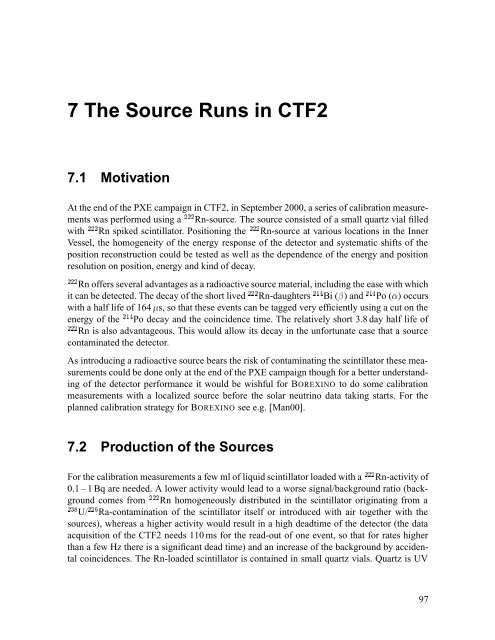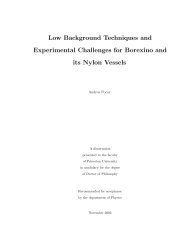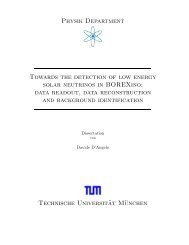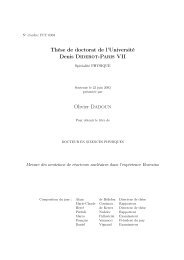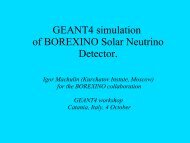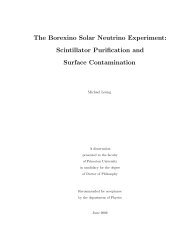Development of a Liquid Scintillator and of Data ... - Borexino - Infn
Development of a Liquid Scintillator and of Data ... - Borexino - Infn
Development of a Liquid Scintillator and of Data ... - Borexino - Infn
Create successful ePaper yourself
Turn your PDF publications into a flip-book with our unique Google optimized e-Paper software.
7 The Source Runs in CTF2<br />
7.1 Motivation<br />
At the end <strong>of</strong> the PXE campaign in CTF2, in September 2000, a series <strong>of</strong> calibration measurements<br />
was performed using a Rn-source. The source consisted <strong>of</strong> a small quartz vial filled<br />
with Rn spiked scintillator. Positioning the Rn-source at various locations in the Inner<br />
Vessel, the homogeneity <strong>of</strong> the energy response <strong>of</strong> the detector <strong>and</strong> systematic shifts <strong>of</strong> the<br />
position reconstruction could be tested as well as the dependence <strong>of</strong> the energy <strong>and</strong> position<br />
resolution on position, energy <strong>and</strong> kind <strong>of</strong> decay.<br />
Rn <strong>of</strong>fers several advantages as a radioactive source material, including the ease with which<br />
it can be detected. The decay <strong>of</strong> the short lived Rn-daughters Bi (¬) <strong>and</strong> Po («) occurs<br />
with a half life <strong>of</strong> 164 s, so that these events can be tagged very efficiently using a cut on the<br />
energy <strong>of</strong> the Po decay <strong>and</strong> the coincidence time. The relatively short 3.8 day half life <strong>of</strong><br />
Rn is also advantageous. This would allow its decay in the unfortunate case that a source<br />
contaminated the detector.<br />
As introducing a radioactive source bears the risk <strong>of</strong> contaminating the scintillator these measurements<br />
could be done only at the end <strong>of</strong> the PXE campaign though for a better underst<strong>and</strong>ing<br />
<strong>of</strong> the detector performance it would be wishful for BOREXINO to do some calibration<br />
measurements with a localized source before the solar neutrino data taking starts. For the<br />
planned calibration strategy for BOREXINO see e.g. [Man00].<br />
7.2 Production <strong>of</strong> the Sources<br />
For the calibration measurements a few ml <strong>of</strong> liquid scintillator loaded with a Rn-activity <strong>of</strong><br />
0.1 – 1 Bq are needed. A lower activity would lead to a worse signal/background ratio (background<br />
comes from Rn homogeneously distributed in the scintillator originating from a<br />
U/ Ra-contamination <strong>of</strong> the scintillator itself or introduced with air together with the<br />
sources), whereas a higher activity would result in a high deadtime <strong>of</strong> the detector (the data<br />
acquisition <strong>of</strong> the CTF2 needs 110 ms for the read-out <strong>of</strong> one event, so that for rates higher<br />
than a few Hz there is a significant dead time) <strong>and</strong> an increase <strong>of</strong> the background by accidental<br />
coincidences. The Rn-loaded scintillator is contained in small quartz vials. Quartz is UV<br />
97


